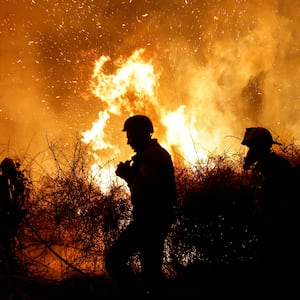SDEROT—The roads from Jerusalem to the Gaza border, about an hour and a half drive, were near deserted as the Israeli war with Hamas entered its fifth day. Israel is still recovering bodies from around the 25 mile perimeter of the Gaza Strip and counting more than 1,200 killed)" href="https://urldefense.com/v3/__https://edition.cnn.com/middleeast/live-news/israel-hamas-war-gaza-10-11-23*h_1d7618d690aa3f9f6be17a53e6138a0c__;Iw!!LsXw!QPnngUbfGXWgzS71FOFtZBQ-wB82EcKHFqugelgjgJfXi0vdUJnBmabPmzFznmW4euCLwHT-WBJdPT3yFzsruhYjocE$">than 1,200 killed in a massive attack on October 7. However, the country now faces the unwelcome prospect of a two-front war. This was driven home to people on Wednesday evening, as sirens sounded throughout northern Israel.
The Israel Defense Forces ultimately said that the sirens were a malfunction. Nevertheless tens of thousands of people in communities near the Lebanon border had been sent scrambling for shelters and safe rooms. “Following the initial report regarding a suspected infiltration from Lebanon into Israeli air space, all civilians in the areas where sirens were sounded are asked to enter shelters and stay in them until further notice,” the IDF said. Residents in the north, speaking to Israeli television soon after the alert, said that they lack enough shelters and the shelters are sometimes far apart.
Meanwhile in southern Israel, near Sderot, IDF soldiers said they identified “a number of vehicles with terrorists in an area adjacent to Kibbutz Nir Am. An IDF tank responded by firing toward them.” This is now the situation Israel faces. Israel has trained for a multi-front war for many years. It has also sought to train to make its army more efficient, using more technology and precision munitions, as well as artificial intelligence. However, the last five days have shaken confidence in these systems. Hamas used numerous small drones to neutralize observation sites around the Gaza border, rendering the IDF blind.)" href="https://urldefense.com/v3/__https://www.france24.com/en/live-news/20231010-snipers-drones-bulldozers-gaza-border-guards-recount-hamas-attack__;!!LsXw!QPnngUbfGXWgzS71FOFtZBQ-wB82EcKHFqugelgjgJfXi0vdUJnBmabPmzFznmW4euCLwHT-WBJdPT3yFzsrgaEn9mQ$">rendering the IDF blind. Then fighters poured through, striking 29 locations in the fence. Israel had invested a billion dollars in a “smart” fence around the Gaza border. However, like the Maginot line, it turned out that massive investment could not always stop a determined enemy.
ADVERTISEMENT
In Sderot, the result of the attack is still clear. In a community center the police have set up a temporary command post because the police station was attacked by 29 terrorists, they said. The terrorists took over the police station and it had to be demolished in order to root them out. I drove to the remains of the station, now a pile of rubble. The community center itself has been struck by a Hamas rocket recently. On Wednesday, Israel’s president came to the center and gave a brief speech after meeting first responders. He said that Israel’s spirit had awakened in the wake of the attack, which he compared to ISIS-like atrocities.
The awakened spirit was clearly evident in Sderot where hundreds of volunteers have streamed to help the local community of 30,000 residents. However, driving out of the city gives one a sense of foreboding. The roads are dark and lonely. There are few cars and the cars that do pass are mostly security vehicles or police. At the entrance to the city of Kiryat Gat, police have set up a checkpoint where the road branches into the city. They have M-4 rifles and are scanning cars.
While the alerts on Wednesday evening were a false alarm, Israel and Hezbollah have been trading fire for several days. The IDF said that “in response to the anti-tank missile fired at IDF soldiers a short while ago, an IDF aircraft struck a military observation post belonging to the Hezbollah terrorist organization in southern Lebanon. Furthermore, IDF artillery struck the area from which the launch originated.”
These kinds of exchanges of fire are unprecedented. Generally, Israel and Hezbollah have refrained from clashes since the 2006 war. There have been several incidents, but the tensions have grown in the last week. The presence of a U.S. aircraft carrier off the coast, and attempts to manage the tensions with Hezbollah risk either a spillover or the chance that Hezbollah is not deterred from further action.
At a rally in Beirut this week, a senior Hezbollah official sent a message to the Palestinian people: “Our hearts are with you. Our minds are with you. Our souls are with you. Our history and guns and our rockets are with you.”
For several tense minutes on Wednesday. Israelis felt that the threat of a multi-front war, similar to 1973 or 1967, was upon them. That fear has not passed. Israel has prepared in the past to face multiple enemies on various fronts, such as Hamas, Hezbollah, Palestinian Islamic Jihad, and also Iran-backed militias in Syria and Iraq. Israel’s Home Front Command has told me in the past that this would mean thousands of rockets fired a day and Israelis needing to be in shelters. This week the IDF reminded people they need to have 72 hours worth of goods ready to remain in their shelter for multiple days in a major war. While preparations for a multi-front war are one thing, the shock of October 7 has brought a feeling that Israel may not be as prepared as it said it was in the past. The reports of Israeli strikes in Syria on Thursday brought home the concerns about this multi-front threat.
With 300,000 soldiers called up in the wake of the Hamas attack, there is no shortage of force. However, the country has ground to a halt with flights canceled and many towns and cities deserted, as families stay home, close to their shelters.







